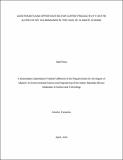| dc.description.abstract | Limited scientific information on decreasing productivity of Arabica coffee (Coffea arabica L.) in Tanzania has been observed. Poor agricultural practices, pests, diseases and climate change are among important factors limiting coffee production. This study assessed how the coffee yield gap was influenced by pests, diseases and agricultural practices. Data were collected through interview, measurements and observations methods. Data collected cover demonstration plots and control plots. Results of the analysis show that, coffee banana plus other shade trees is mostly practiced system. Plots were affected by pests and diseases across the altitude gradient. However, the demonstration plots were performing better with mean yield of 807 kg ha-1 and range from 35 to 1800 kg ha-1 as compared to control plots, which had a mean yield of 550 kg ha-1 and range from 18 to 1800 kg ha-1. Large yield gap was partly attributed to the incidence of red spider mite (Tetranychus urticae) and interaction effects of coffee berry disease (Colletotrium caffeanum) and coffee thrips (Diarthrothrips coffeae). Poor agricultural practices especially decreased shade trees density and banana mats density, interactions effects of mulching and weeding and weeding and replanting of coffee trees contributed to the substantial yield gap. In addition mulching, irrigation and shade trees and management are best opportunities to mitigate current global rise in temperature. Thus, it can be concluded that, priorities such as adaptation measures of climate change, pests and diseases control and improved agricultural practices such weeding, fertilizer application, mulching and pruning are recommended to enhance coffee yield. | en_US |

